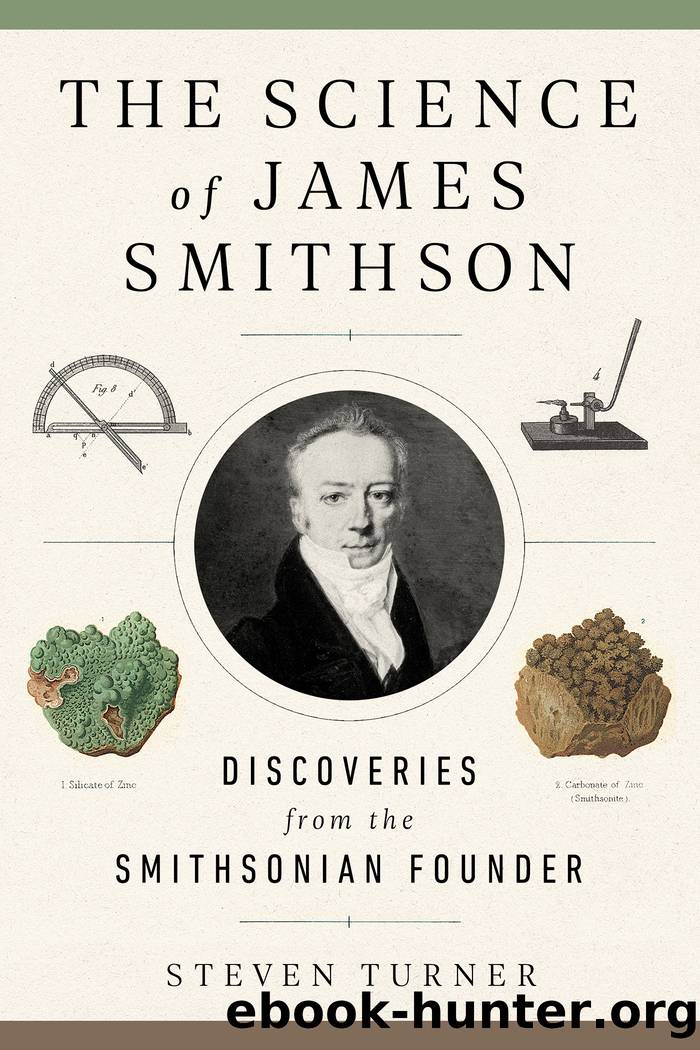The Science of James Smithson by Steven Turner

Author:Steven Turner [Turner, Steven]
Language: eng
Format: epub
Publisher: Smithsonian
Published: 2020-11-03T00:00:00+00:00
14.
A NEW TEST FOR ARSENIC AND âSMITHSONâS PILEâ
IN 1822, James Smithson wrote an article describing a method he used for detecting arsenic. Curiously, he had written about this test just a few years earlier, and once he had written on a subject it was unusual for him to revisit it. But in this case, he explained, the âimportance of the subjectâ justified it. The subject was the need to identify the agents in cases of suspected poisoning, and it was a problem that many chemists were struggling with. Poisons were an increasing danger in the early nineteenth century, not only in cases of deliberate poisoning but also from the growing problem of environmental pollution. One of the unintended effects of the Industrial Revolution had been to bring vast quantities of toxic materials into contact with humans, and one of the challenges of Smithsonâs time was to find ways to deal with this. Two of the most problematic substances were arsenic and mercury, and in his article, Smithson described sensitive new methods to detect each of them.
The bulk of the article was devoted to the test for arsenic. In 1817, the noted physician and toxicologist Mathieu Orfila had written that âthe preparations of arsenic are, of all the poisonous substances in the mineral kingdom, the most fatal.â And yet in England, where arsenic was widely used as a pesticide, it was essentially unregulated and readily available.
Arsenic, the twentieth most common element in the earthâs crust, is gray in its âelementalâ form, with a metallic appearance. Surprisingly, in this form it is not poisonous. Arsenic is only poisonous when combined with other elements, and the form usually used as a poison is a combination of arsenic and oxygen commonly known as âwhite arsenic.â Known to the public in Smithsonâs time as âratsbaneâ and to chemists as âarsenious acid,â it has no distinctive taste or smell. When ground into a powder it looks very much like sugar or flour, so it could be added to foods and beverages without arousing suspicion. It is not very soluble in liquids, however, so as a poisoned food or drink cooled the arsenic often settled out of solution, giving it a gritty texture, one of the few indicators of its presence.
By the time this happened, the victim had usually consumed some of the arsenic, and it did not take much to be fatal. In Smithsonâs time substances were generally measured in grains, a grain being the average weight of a single grain of wheat. Depending on a personâs physiology, a lethal dose usually consisted of no more than four or five grains, although death could result from as little as two.
The initial symptoms of arsenic poisoning were acute abdominal pain and rapid pulse, followed by convulsions, and then severe vomiting and diarrhea, often leading to death. Arsenic was the chief example of what early toxicologists called an âirritant poison,â and it was a particularly unpleasant way to die. Autopsy typically revealed severe damage to the digestive tract,
Download
This site does not store any files on its server. We only index and link to content provided by other sites. Please contact the content providers to delete copyright contents if any and email us, we'll remove relevant links or contents immediately.
The Complete Stick Figure Physics Tutorials by Allen Sarah(7264)
Secrets of Antigravity Propulsion: Tesla, UFOs, and Classified Aerospace Technology by Ph.D. Paul A. Laviolette(5237)
Thing Explainer by Randall Munroe(3849)
The River of Consciousness by Oliver Sacks(3498)
The Order of Time by Carlo Rovelli(3097)
How To by Randall Munroe(2969)
A Brief History of Time by Stephen Hawking(2911)
I Live in the Future & Here's How It Works by Nick Bilton(2900)
The Great Unknown by Marcus du Sautoy(2612)
What If?: Serious Scientific Answers to Absurd Hypothetical Questions by Randall Munroe(2589)
Midnight in Chernobyl by Adam Higginbotham(2432)
Blockchain: Ultimate Step By Step Guide To Understanding Blockchain Technology, Bitcoin Creation, and the future of Money (Novice to Expert) by Keizer Söze(2409)
Networks: An Introduction by Newman Mark(2304)
The Meaning of it All by Richard Feynman(2268)
Easy Electronics by Charles Platt(2252)
The Tao of Physics by Fritjof Capra(2204)
Midnight in Chernobyl: The Untold Story of the World's Greatest Nuclear Disaster by Adam Higginbotham(2126)
When by Daniel H Pink(2057)
Introducing Relativity by Bruce Bassett(2048)
